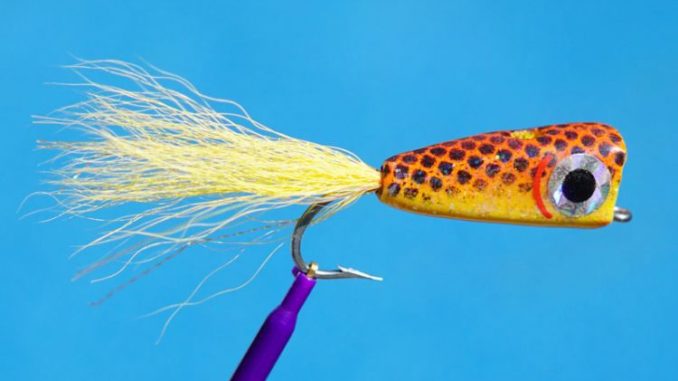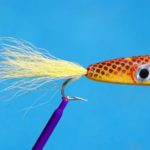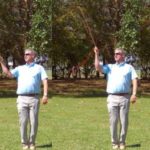
Why top fly anglers use ‘the Belgian’
I never do a presentation on fly fishing for speckled trout without including the Vertically Oriented Strike Indicator (VOSI). My creation has helped me to catch thousands of specks on the long rod.
For those readers who aren’t familiar with the VOSI, it’s basically a small styrofoam perch float cut in half, with a concave face carved out on the “fat end” using a Dremel cone.
On your leader, slip the VOSI up with the concave face towards the fly line, and push the pin into the slot on the fly end. The suspending fly is usually a shrimp pattern or Clouser Minnow.
What you have is the flyrodders’ popping cork. Stripping the line makes the VOSI pop which gets attention. It also creates a vertical movement of the fly underneath.
A tangled web we cast
One of the biggest challenges in fishing a VOSI-fly combination is avoiding tangles when casting. That’s true of all complex rigs – whether it’s multiple flies tied together by sections of tippet, or flies under a strike indicator.
With simple rigs (one fly by itself), the ideal casting style is a tight loop overhead cast. This is the classic stroke where the caster raises the rod tip slowly, accelerates starting at the 10 o’clock position, and then does a hard stop at the 1 o’clock position.
After a brief pause, the caster accelerates the rod tip forward to the 10 o’clock position for a hard stop. If it’s the delivery stroke, then the caster slowly drifts the rod tip down to the water as the line unfolds to its target.
A properly done overhead cast, with its narrow arc and hard stops, loads more potential energy into the rod. The result is a tight loop cast yielding maximum distance with low wind impact and good accuracy.
However, with complex rigs, such casts can result in tailing loops and subsequently, messy tangles.
One solution is to open up the casting arc to make a more open loop. This works great for short casts, but not for longer casts or casts in windy conditions.
Another solution is the Belgian cast.
A planetary concept
Shortly after World War II, Hans Gebetsroither, a shoemaker and river keeper in Austria, began experimenting with a new casting style that was effective in just about any fishing situation.
The Gebetsroither style starts off with a side backcast, but rather than stopping at any point, the arm continues in a continuous elliptical motion before swinging overhead and forward to the target.
In effect, the rod tip is making an oval motion in the air, with no stopping until the delivery.
Think of the flies under this style similar to planets orbiting the sun. The rotational tension keeps them separated, so there’s no crossing each other like in an overhead cast.
The fly line is also loading the rod during the entire backcast. So this style allows for longer casts than with an open loop.
Belgian, Austrian … whatever
The Belgian Cast is also known as the Austrian cast, elliptical cast, oval cast, rotational cast and Gebetsroither style.
How did this cast get so many different names?
In 1958, the first world casting championships were held in Brussels. Albert Goddart, a fishing companion of Gebetsroither, was representing Austria. He used his friend’s cast to win the silver medal.
Several Americans at the event took notice of his unique cast and started calling it the Belgian cast after the country the championships were held in.
Over the decades, casting instructors have referred to it with names that best describe the cast itself – oval, elliptical, etc.
In recent years, political correctness has established that the cast be referred to as the Austrian cast or Gebetsroither style.
Many names, many uses
Whatever you wish to call the Belgian cast, know that it works for more than just complex rigs. In fact, I use this cast much of the time.
Jeff Ferguson is a Fly Fishers International (FFI) Master Certified Casting Instructor from Lake Charles. Jeff points out that the elliptical cast is more efficient because circular movements are a better fit for the arm’s biorhythm than hard stops. Once you master the Belgian cast, you can make more casts with less fatigue.
He also notes this cast comes in handy when dealing with bulky or heavy flies, or casting on windy days. The roundabout motion keeps the fly away from the angler on the backcast where most “angler collisions” occur.
For those wishing to learn more about the Belgian cast, Jeff will be demonstrating it at the Contraband Fly Fishing Expo to be held July 13-14 in Lake Charles. Details can be found at www.contrabandflycastersinc.net.




